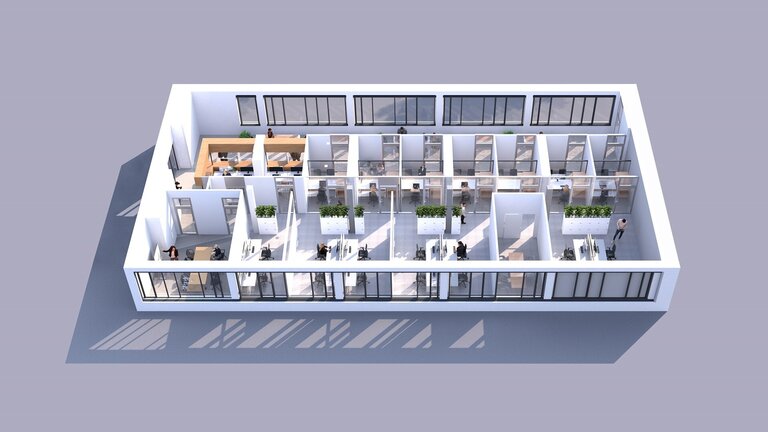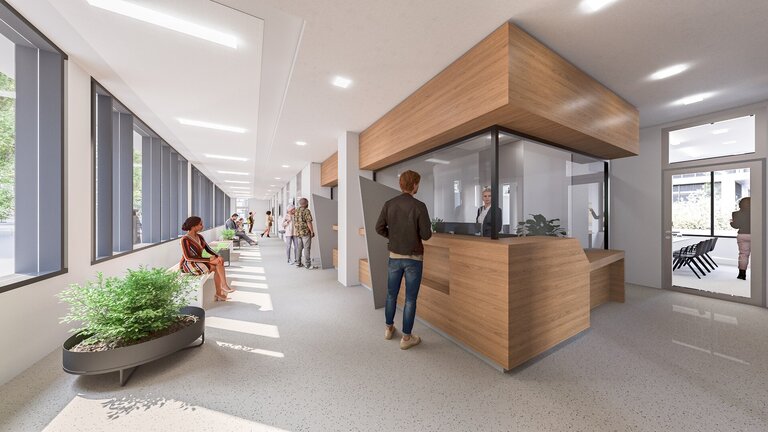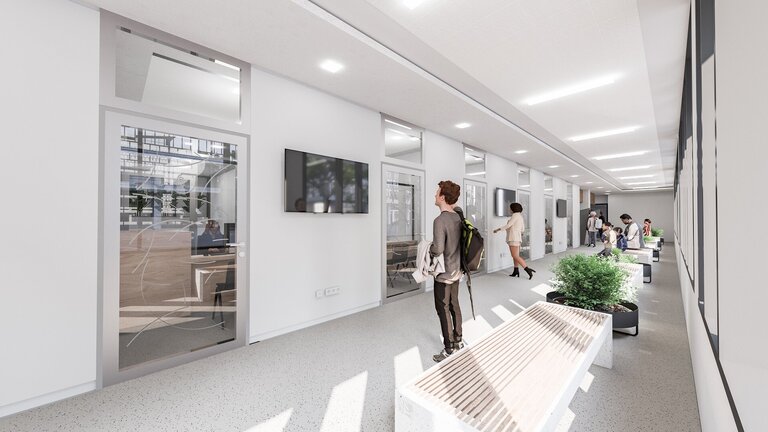Waiblingen, Germany, May 19, 2023. Central service points, space for consultation and meetings, and a working area not accessible to visitors: the new administration building of the Rems-Murr rural district in the German city of Waiblingen will consist of a public zone, a semi-public zone and an internal zone. With this special usage concept, the rural district treads new ground and creates a model for modern public administration offices in Germany. Drees & Sommer SE participated in the development of the spatial and usage concept for the administration complex. The Stuttgart-based consulting company has provided the rural district with advice on their overall real estate strategy since 2017. The new building was officially opened on May 17.
The new administration building in Rötestrasse is a first module in the overall real estate concept of the Rems-Murr rural district in the city of Waiblingen. In future, it is planned that there will be only two large administration buildings in Waiblingen instead of the ten small sites which have existed up to now. After two and a half years of building work, the new building on the former site of the Ludwig Schlaich Academy was officially opened by the district commissioner, Dr. Richard Sigel, on May 17.
The new building was designed and planned by BK2H Architekten, has an underground car park and comprises a net internal area of about 3600 square meters. In future it will accommodate the foreign persons registration office, the public order office and the public health department. The approximately 170 employees of these three departments deal with matters which are especially confidential, emotional and sometimes involve sensitive security issues. The new spatial concept takes this into account and sub-divides the space on a three-zone principle, creating a public zone, a semi-public zone and an internal zone.
‘Even before the Covid-19 pandemic we knew how difficult it can be to organize the movement of visitors in administrative offices in difficult circumstances. The events surrounding the refugee crisis in 2015/16 already showed me that the procedures in an administrative building need to be thoroughly redesigned. Together with Drees & Sommer, we therefore ensured that the goal of becoming more modern, more digital and smarter as an administration was firmly integrated into the planning process for our new administration building from the very first day. With the three-zone principle we offer citizens a professional consulting environment and provide our employees with a safe and efficient place to work which is equipped for the requirements of the future. The new spatial concept also creates flexibility and embodies a fresh design for working procedures, even catering for the mobility of employees who come to work by bike. New working models, including working from home and a high proportion of part-time jobs, can also be taken into account in the best possible way,’ explained district commissioner Dr. Richard Sigel.
The Three-Zones Principle Ensures Efficiency and Safety.
In the public zone, each of the three departments will in future have a service point as the first place of contact for visitors with and without an appointment. Many questions and concerns can be dealt with here directly. In many cases, there is then no need for an appointment with the subject department, which saves time for visitors and makes life easier for the specialist staff.
The second semi-public zone contains the consultation and meeting areas. ‘In future, appointments will no longer take place in the offices of the staff, they will be held in rooms which are appropriate in their size, equipment and privacy for the individual concerns of the citizens,’ comments senior Manager Sven Mylius, Drees & Sommer’s responsible consultant for the concept. There are small rooms for individual appointments, rooms with extra space for prams and pushchairs and larger rooms for groups of visitors and families.
‘Waiting in corridors, which is common in so many administration buildings, will be a thing of the past in Waiblingen. Instead, there will be separate waiting rooms offering a more pleasant place to wait,’ adds Sven Mylius. The public health department will have a separate waiting area for people with contagious diseases and rooms for medical examination and advice with discrete access. On the whole, however, a new appointment scheduling system aims to ensure that the citizens have hardly any waiting times. The public order department will also have specially equipped areas. For example, there will be designated bullet-proof areas where citizens can hand in loaded weapons which they have inherited.
Paperless Office Policy and Desk Sharing in the Internal Zone
The internal area in zone three is exclusively reserved for the approximately 170 employees. This zone is entirely without visitors and citizens and contains the workplaces for the staff. ‘In traditional administration buildings, visitors can usually move freely through the building without any restrictions.
Waiting areas are often on the corridors, and the staff frequently receive visitors at their own workplace. This involves high risks for data privacy, and it offers the employees no protection from physical attacks, which are unfortunately becoming more common throughout Germany. The three-zones-principle enhances the security of staff and also the level of discretion and data privacy,’ explains the Sven Mylius, Drees & Sommer’s work environment expert.
The new concept does not include individual offices, instead it is based on shared offices, i.e. the principle of desk sharing – and this applies at all levels in the hierarchy. To plan this system, first of all this required extensive analysis of the existing situation. What needs, habits and requirements do the later users of the building have for their workplaces? Who will be in the building at what times, who will often work away from the office, who uses the phone a lot? These points were identified in detail in workshops with the external experts, and the documented results were used to calculate a desk sharing ratio.
For different types of activity the employees can now choose between workstations with different levels of equipment. The district commissioner Dr. Richard Sigel has demonstrated for some time how well this works: he gave up his individual office several years ago. One factor which makes this transition more feasible is that the offices are largely paperless and the staff work mainly with electronic files. To facilitate communication and contact among the staff, the internal area contains rooms for formal meetings and places which can be used for informal social contact and exchange. These facilities include both multi-functional rooms and small cafés which are planned to be situated between the departments to facilitate contact between staff working in the different subject areas.
The team of experts from Drees & Sommer held about fifteen workshops with the employees and management of the district authority to identify and document the user requirements for the new building and work in close cooperation with the architects to include these requirements in the floor plans for the building. ‘The vision behind the new usage and work concept, its targets and guidelines, will apply to all future projects of the district administration,’ adds district commissioner Dr. Richard Sigel.


